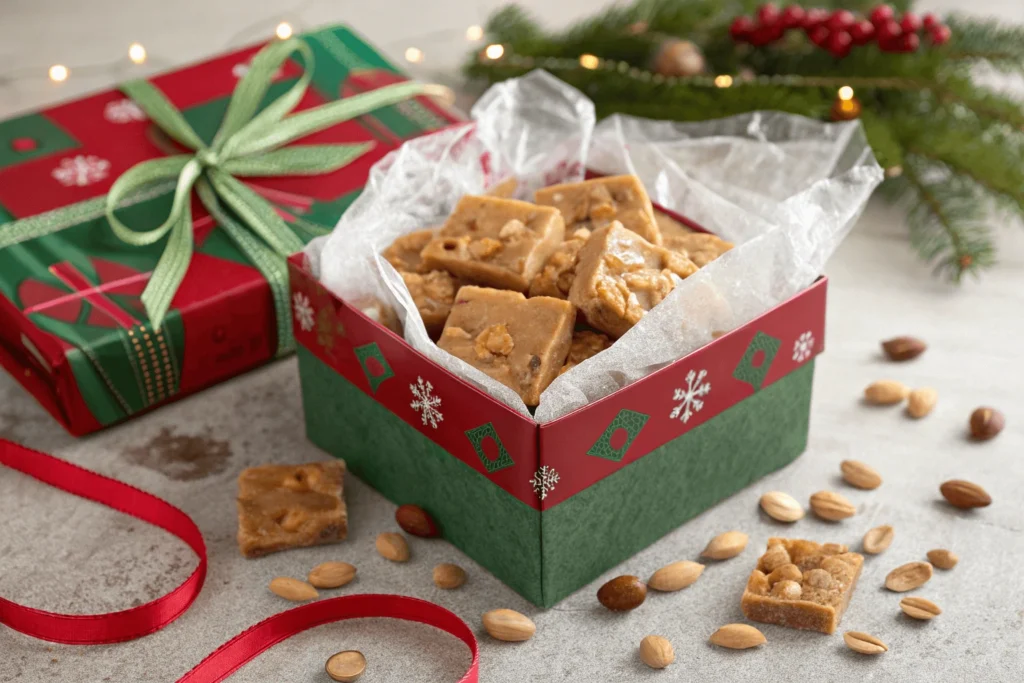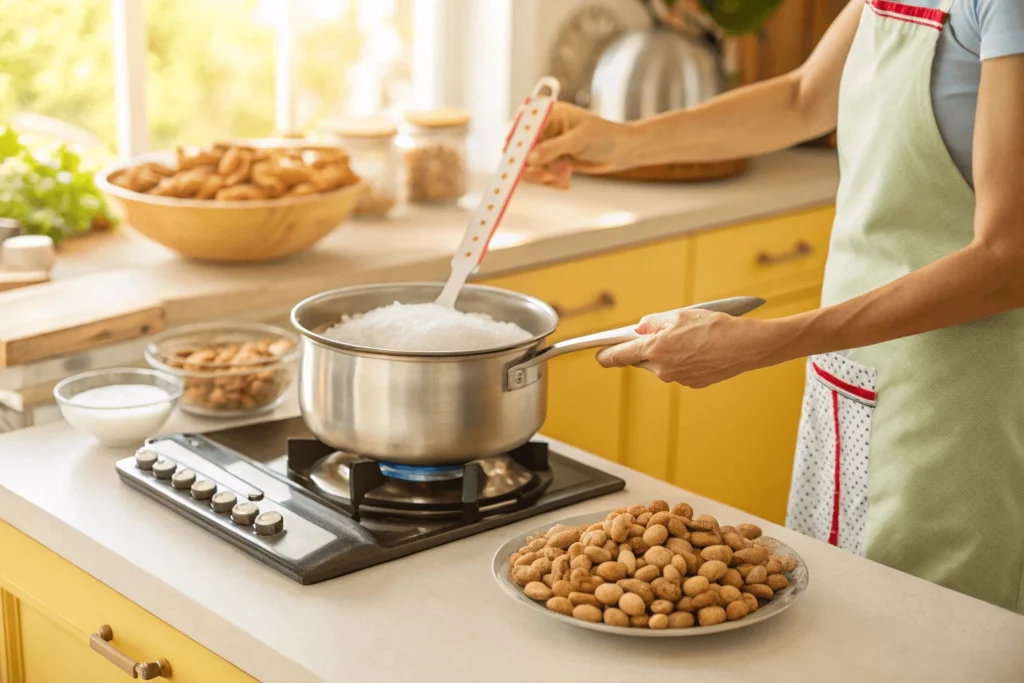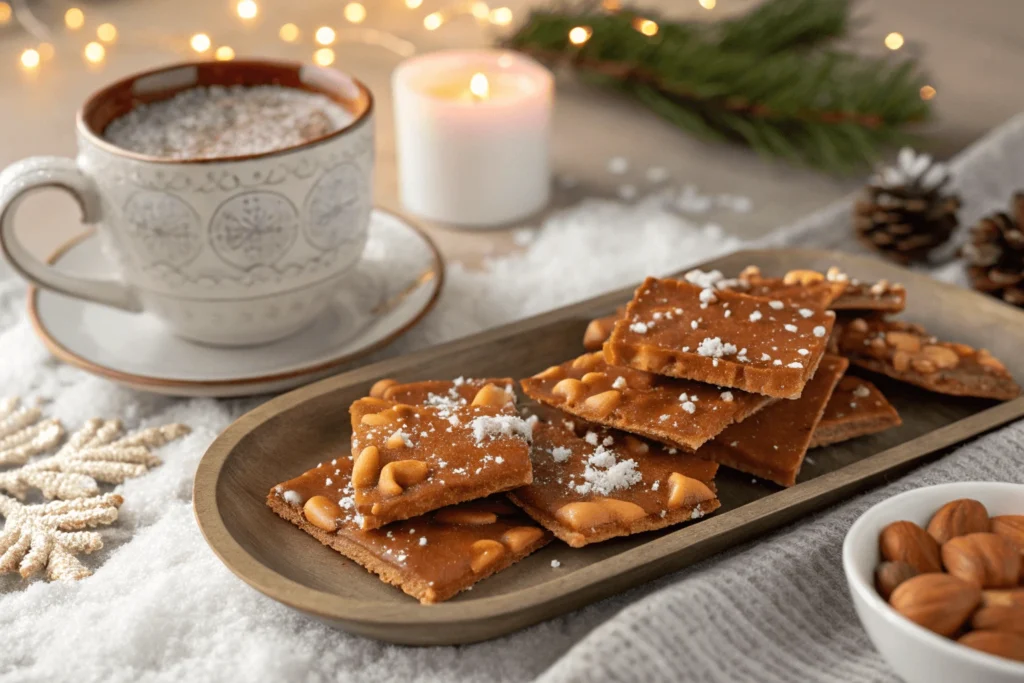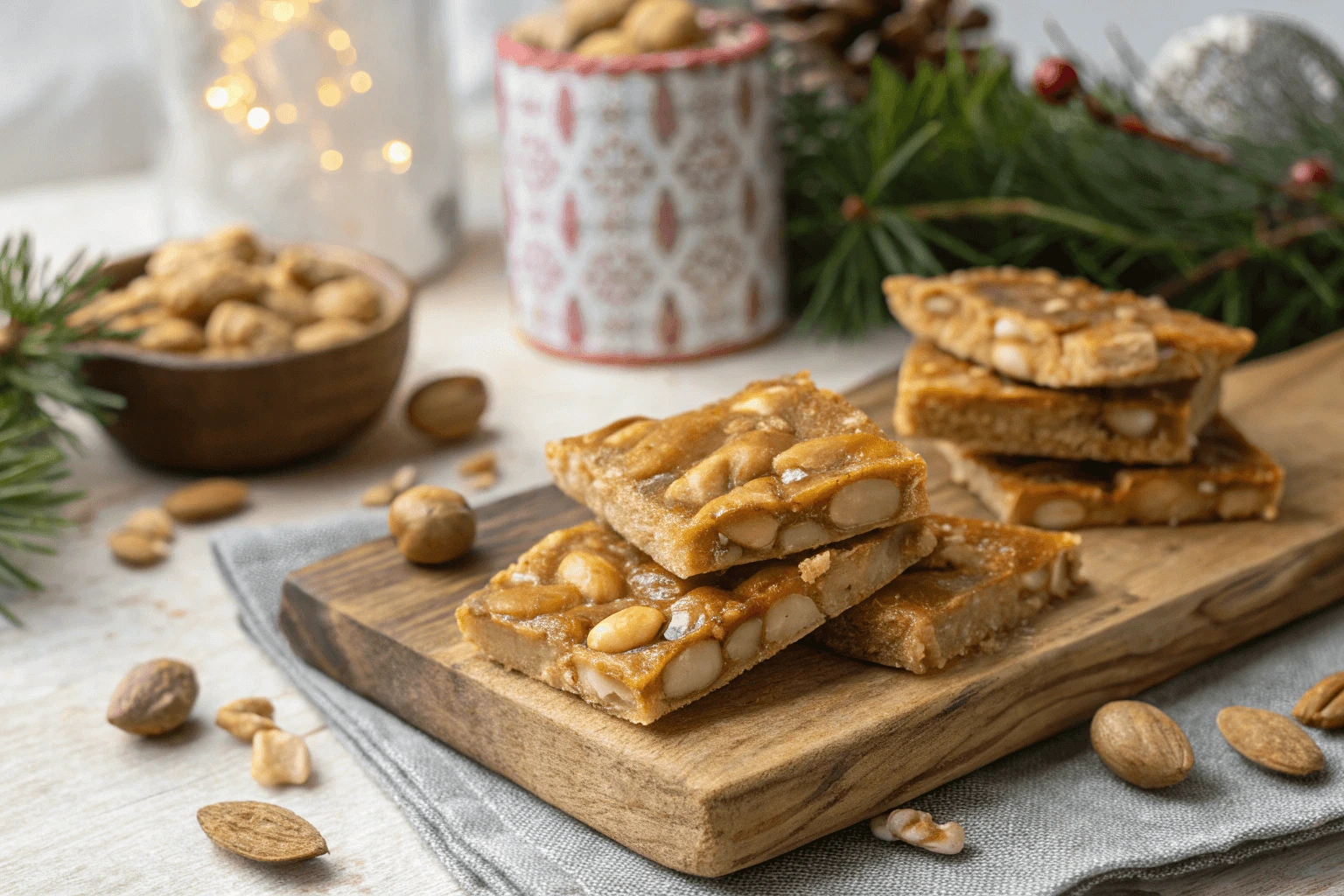Table of Contents
Peanut brittle is a timeless classic that’s often associated with holiday celebrations and family gatherings. This sweet, crunchy candy made with peanuts and sugar syrup has been a favorite treat for generations. Whether it’s Christmas, Thanksgiving, or simply a cozy winter snack, homemade peanut brittle brings warmth and joy to any occasion.
Making peanut brittle at home is easier than you might think, and with a few simple ingredients, you can create a batch that rivals store-bought versions. In this post, we’ll walk you through a step-by-step guide to making the perfect homemade peanut brittle, along with tips, tricks, and variations to customize it to your taste. Prepare to wow your friends and family with this irresistible, timeless treat!

What Is Peanut Brittle and Why It’s a Classic Holiday Treat
Define Peanut Brittle and Its Origins
Peanut brittle is a traditional candy made by combining sugar, corn syrup, and roasted peanuts, then heating the mixture to a high temperature until it reaches the hard-crack stage. The result is a crunchy, golden treat that features the perfect balance of sweet and nutty flavors. While peanuts are the star of this brittle, the sugar syrup plays an essential role in giving the candy its signature texture. The mixture hardens as it cools, creating thin, crisp layers that are both delicate and satisfying to break into bite-sized pieces.
The origins of peanut brittle can be traced back to the early 19th century, with its roots in both European and American candy-making traditions. Many food historians believe the candy’s roots lie in a simpler form of “brittle,” which was likely made from nuts like almonds or hazelnuts and cooked with sugar. The shift to peanuts, a more readily available and affordable ingredient, took place in the United States in the late 1800s, particularly in the southern states where peanuts were widely grown.
Some believe peanut brittle’s popularity soared after it was introduced at fairs and circuses in the early 20th century, where vendors would sell the candy as a quick, portable snack. Others point to its inclusion in homemade holiday gift baskets and festive treat trays as the reason for its enduring presence during Christmas, Thanksgiving, and other family-oriented celebrations.
Today, peanut brittle continues to be a beloved treat, with its rich history adding to its charm. Whether it’s made with traditional peanuts or variations like almonds, cashews, or even chocolate, peanut brittle remains a symbol of sweet nostalgia and a timeless holiday favorite.
Why Peanut Brittle is a Popular Holiday Snack
Peanut brittle is much more than just a crunchy candy—it’s a beloved tradition that has been passed down through generations, often making its appearance during the holidays. There are several reasons why this sweet treat remains a favorite during festive times like Christmas, Thanksgiving, and New Year’s Eve.
Balance of Sweet and Salty: The combination of sweet sugar syrup and salty roasted peanuts makes peanut brittle an irresistible snack. During the holidays, when savory snacks and rich desserts are abundant, the balance of sweet and salty in peanut brittle hits just the right note. It complements other holiday treats and provides a satisfying crunch that many holiday snacks lack.
Perfect for Gifting and Sharing: One of the primary reasons peanut brittle is a holiday favorite is its versatility as a gift. Homemade treats, especially when packaged beautifully, make for thoughtful and personal gifts. Whether wrapped in a festive tin or placed in a decorative jar, peanut brittle serves as a delightful offering to friends, family, and colleagues. It’s easy to make in large batches, so it’s a practical choice for gift-giving.
Easy to Make in Bulk: During the holidays, there’s often a rush to create and serve a variety of snacks and desserts. Peanut brittle fits perfectly into this busy season, as it can be prepared quickly and in large quantities. The recipe uses common pantry ingredients like sugar, peanuts, butter, and corn syrup, making it an accessible and cost-effective treat to prepare for gatherings and celebrations.
Long Shelf Life: Unlike many holiday treats that need to be consumed quickly, peanut brittle has a long shelf life. When stored properly in an airtight container, it can stay fresh for weeks, making it ideal for busy holiday schedules. This feature allows families to enjoy the candy over several weeks, and it also makes it easy to have a stockpile of treats ready for unexpected guests or last-minute party needs.
Nostalgic Comfort: For many people, peanut brittle is more than just a snack; it’s a cherished holiday tradition. The act of making peanut brittle often becomes a bonding experience, with families coming together to prepare this treat each year. The aroma of caramelizing sugar and roasting peanuts is a nostalgic reminder of past holidays, evoking fond memories of loved ones and joyful times spent together.
Mention its versatility for different occasions (Christmas, New Year’s Eve, etc.)
Peanut brittle is a versatile treat that can easily adapt to various occasions, making it a go-to option for many holiday celebrations and special events. Its sweet and salty flavor, along with the satisfying crunch of peanuts, makes it a crowd-pleaser at any gathering.
Christmas and Holiday Season: Peanut brittle has long been associated with Christmas, often found in gift baskets, stockings, or as part of a holiday dessert spread. Its festive appearance—whether served in small, bite-sized pieces or packaged in decorative tins—makes it an ideal homemade gift. Plus, the warm, sugary aroma filling your kitchen while making the brittle adds to the cozy, holiday atmosphere.
New Year’s Eve: As we usher in the New Year, peanut brittle can be a delightful addition to party platters. Its simplicity and indulgent sweetness complement more elaborate treats, providing a perfect balance to richer snacks like chocolate or savory hors d’oeuvres. Whether served at a midnight snack table or as part of a festive dessert buffet, peanut brittle is sure to impress your guests.
Thanksgiving and Fall Celebrations: The combination of roasted peanuts and caramelized sugar offers a comforting flavor that pairs well with the cozy vibes of fall. During Thanksgiving, it can be a nice addition to a dessert spread, offering a sweet treat to enjoy after the main meal. Peanut brittle can also be served at autumn gatherings, such as harvest festivals, or packed as a tasty snack for outdoor picnics and road trips.
Gifts and Party Favors: One of the best things about peanut brittle is its ability to be packaged beautifully. Whether you’re wrapping it in cellophane with a festive ribbon or placing it in mason jars with a personalized label, peanut brittle makes a thoughtful and edible gift. It’s perfect for gifting during the holiday season or for any occasion where you want to give a little something sweet to friends, neighbors, or coworkers.
Casual Gatherings or Movie Nights: While peanut brittle is often linked to holidays, its appeal isn’t limited to special events. It’s a great treat to have on hand for casual get-togethers, game nights, or movie marathons. The crunchy texture and rich sweetness make it an irresistible snack, and it’s easy to prepare in advance so you can have it ready for whenever the craving strikes.
Whether you’re celebrating a major holiday or just enjoying a quiet evening at home, peanut brittle’s adaptability makes it the perfect choice for any occasion.

Essential Ingredients for Homemade Peanut Brittle
Making peanut brittle requires only a few key ingredients, but each one plays an important role in creating that perfect sweet and crunchy treat. Understanding the purpose of each ingredient will help you achieve the ideal texture, flavor, and consistency. Let’s dive into the essential ingredients that make up this classic candy.
Peanuts: Types of Peanuts (Roasted, Unsalted) and Their Role in the Recipe
Peanuts are the star of peanut brittle, providing the signature crunch and flavor. When selecting peanuts for your recipe, there are a few options to consider:
- Roasted Peanuts: Roasted peanuts bring a deeper, more developed flavor to the brittle. Whether you use salted or unsalted roasted peanuts, they provide that distinct nutty taste that pairs perfectly with the caramelized sugar syrup.
- Unsalted Peanuts: If you’re using salted peanuts, be cautious about the overall salt content in your brittle. Unsalted peanuts give you more control over the sweetness and ensure your candy doesn’t become overly salty. They also allow the sugar to shine and balance the nutty flavors.
- Raw Peanuts: While raw peanuts can technically be used, they may need to be roasted first for the best flavor. Using raw peanuts without roasting can result in a less rich and underdeveloped taste.
Roasted unsalted peanuts are typically preferred for their balance of flavor and texture in peanut brittle. The peanuts are mixed into the syrup and create the signature crunchy texture of the brittle once cooled and broken into pieces.
Sugar: The Importance of Using the Right Sugar for Caramelization
Sugar is a vital component in the creation of peanut brittle. It provides sweetness and, more importantly, helps form the caramelized syrup that coats the peanuts and hardens into a brittle texture. The type of sugar you use can significantly affect the flavor and texture of the final product.
- Granulated White Sugar: Most peanut brittle recipes call for regular granulated sugar, which melts into a clear syrup that caramelizes at the correct temperature. It’s essential to use the right sugar to achieve that ideal, golden-brown color and sweet flavor.
- Brown Sugar: Some variations of peanut brittle include brown sugar, which adds a hint of molasses and a deeper, richer flavor. If you want a more caramel-like flavor, swapping out some of the white sugar for brown sugar can enhance the depth of your brittle.
The key to perfect peanut brittle is ensuring the sugar reaches the right temperature, around 300°F (hard crack stage), where it transforms into a crisp, hard texture once cooled. Overheating the sugar can cause it to burn, so precise temperature control is crucial.
Corn Syrup: Why It’s Often Used in Peanut Brittle Recipes
Corn syrup is another critical ingredient in peanut brittle recipes. While it may not add much flavor, corn syrup plays an important role in the texture and consistency of the candy. Here’s why it’s commonly used:
- Prevents Crystallization: Corn syrup helps to prevent the sugar from crystallizing during the cooking process. Without it, your syrup could turn grainy or have a rough texture, making the brittle less smooth and enjoyable. The syrup creates a glossy, smooth candy that has the perfect bite.
- Adds Softness: While peanut brittle is known for its hard, crunchy texture, corn syrup helps balance that with a slightly softer and more even crunch. This means your brittle won’t be too tough to break and will have a pleasant snap.
- Enhances Stability: The addition of corn syrup helps stabilize the mixture, making it easier to handle and shape the brittle once it’s poured onto a baking sheet to cool.
Using corn syrup in the right quantity ensures that your peanut brittle achieves the perfect texture and doesn’t turn out too brittle or sticky.
Butter and Vanilla: How They Enhance the Flavor and Texture of the Brittle
Butter and vanilla are essential flavor enhancers in peanut brittle, and they contribute to both the taste and texture of the candy:
- Butter: Butter adds a rich, creamy flavor that balances out the sweetness of the sugar. It also helps to create a smoother, silkier texture as the brittle cools. The fat in butter prevents the candy from being too sticky and ensures it has that satisfying crunch when broken into pieces. Some recipes also call for a small amount of salt to complement the sweet and savory notes of the brittle.
- Vanilla Extract: While the flavor of vanilla is subtle, it adds a warm, aromatic quality that enhances the overall taste of the peanut brittle. It provides a slightly floral and comforting note that balances the sweetness of the sugar and the richness of the butter. Vanilla is a classic addition that rounds out the flavors and makes your peanut brittle truly special.
Together, butter and vanilla help create the ideal balance of sweetness, richness, and flavor, ensuring your peanut brittle is not only crispy but also incredibly delicious.
These essential ingredients come together to create the perfect peanut brittle with that perfect balance of flavors and textures. By understanding how each ingredient contributes, you can make adjustments based on your personal taste and preferences, ensuring every batch is a success.
Step-by-Step Guide to Making Perfect Peanut Brittle
Making peanut brittle might seem tricky at first, but with the right steps and attention to detail, you’ll be able to create a batch that’s just as good (if not better) than any store-bought version. Follow this easy-to-understand guide to ensure your homemade peanut brittle turns out delicious and crunchy every time.
Preparing the Ingredients: Prepping Peanuts, Measuring Sugar, and Other Ingredients
Before you begin cooking, make sure all your ingredients are prepared and ready. This helps the cooking process flow smoothly and ensures you don’t miss any crucial steps.
- Peanuts: If you’re using raw peanuts, roast them in the oven at 350°F for about 10 minutes to bring out their nutty flavor. You’ll want to use unsalted peanuts to avoid overpowering the sweetness of the brittle. Once roasted, set them aside to cool.
- Measuring Sugar: Accurately measuring your sugar, corn syrup, and butter is key to achieving the perfect brittle texture. You’ll need granulated sugar, corn syrup, and a generous amount of butter. Using a kitchen scale to measure the sugar can help ensure consistency, but if you’re using measuring cups, be sure to level them off properly.
- Other Ingredients: Don’t forget the smaller ingredients that add to the flavor and texture. These include baking soda (which helps the brittle expand and become airy) and vanilla extract (for a nice depth of flavor). Make sure to have these ready to add in once the syrup reaches the correct temperature.
Cooking the Syrup: Importance of Controlling the Temperature and the Role of a Candy Thermometer
The sugar syrup is the heart of the peanut brittle, so it’s crucial to cook it to the right temperature to achieve the perfect crunch.
- Cooking the Syrup: In a large saucepan, combine the sugar, corn syrup, and butter. Stir them together over medium heat until the butter is fully melted and the sugar begins to dissolve. When the mixture begins to boil, cease stirring. Stirring can cause the sugar to crystallize and ruin the smooth texture of the brittle.
- Using a Candy Thermometer: A candy thermometer is essential for ensuring your syrup reaches the right temperature. As the mixture boils, monitor the temperature closely. You’ll want to cook the syrup until it reaches 300°F (also known as the hard crack stage). This is the point where the syrup is firm enough to create the signature crunch in your peanut brittle.
- Watching for Color Changes: As the syrup cooks, you’ll notice it will begin to change color, turning from a pale golden yellow to a darker amber. This color change is an important indicator that the syrup is approaching the right temperature. However, always rely on the thermometer for precision, as color alone isn’t always an accurate guide.
Achieving the Perfect Crunch: How to Know When the Brittle is Ready and Tips for Texture
Getting the right texture for your peanut brittle is one of the most important aspects of the recipe. The goal is a crispy, crunchy treat that shatters perfectly when broken into pieces.
- Using the Candy Thermometer Correctly: The key to the perfect crunch is reaching the 300°F mark. If the temperature is too low, the brittle will be chewy instead of crunchy. If the temperature is too high, the brittle will become too hard and potentially brittle to the point of being difficult to break into pieces. Stick to the thermometer’s reading for the most accurate results.
- Testing the Syrup with the Water Test: If you don’t have a candy thermometer, you can use the water test to check the syrup’s doneness. Place a small spoonful of the syrup into a glass of cold water. If it hardens immediately and forms brittle threads, the syrup is at the correct temperature.
- Incorporating Peanuts: Once the syrup is ready, quickly stir in the roasted peanuts. The syrup will start to thicken as it cools, so you need to work fast to evenly coat the peanuts. Don’t worry if the mixture seems to seize up a little—it will loosen as you continue stirring.
Cooling and Breaking the Brittle: How to Cool the Mixture Properly and Break it into Pieces
Once your peanut brittle is fully cooked, it’s time to let it cool and break it into the signature shards that make it so irresistible.
- Pouring the Mixture: Immediately pour the hot peanut mixture onto a parchment-lined baking sheet or a silicone mat. Spread it out as evenly as possible using a spatula, but don’t press down too hard. You want the brittle to be thin and uniform in texture, but overworking it can cause the syrup to soften.
- Cooling the Brittle: Allow the peanut brittle to cool completely at room temperature. This usually takes between 30 minutes to an hour. It’s crucial not to rush this step by trying to cool it in the fridge, as rapid cooling could cause the brittle to become brittle in the wrong way.
- Breaking into Pieces: Once cooled and hardened, break the peanut brittle into shards using your hands or a kitchen mallet. If you’re looking for a more uniform appearance, you can use a knife to cut it into squares or rectangles. The shards should be crisp and should break easily with a snap, indicating the perfect crunch.
- Storing the Brittle: To maintain freshness, store your peanut brittle in an airtight container at room temperature. It should stay crunchy for up to two weeks, though it’s likely to be eaten much sooner!

Common Mistakes to Avoid When Making Peanut Brittle
Making peanut brittle seems straightforward, but there are a few common pitfalls that can affect the quality of your candy. Understanding these mistakes and how to avoid them will ensure that your homemade peanut brittle turns out perfect every time.
For a deeper dive into candy-making tips and techniques, check out this comprehensive guide to candy-making on Serious Eats, where you can find expert advice on temperature control, sugar stages, and mor
Overheating the Sugar Mixture and the Risk of Burning
One of the most critical aspects of making peanut brittle is carefully controlling the temperature of the sugar mixture. Overheating the syrup can lead to burnt sugar, which will not only affect the flavor but can also make the brittle too hard and bitter. The sugar syrup should reach the perfect temperature to allow for proper caramelization without burning.
The key is to heat the sugar mixture slowly over medium heat, stirring constantly to prevent scorching. If the syrup starts to darken too quickly or begins to smell burnt, it’s a sign that it has overheated. Ideally, you want to aim for a temperature between 300°F and 310°F (150°C and 155°C) on a candy thermometer. This is when the sugar reaches the “hard crack” stage, which is perfect for achieving that crispy, crunchy texture without the risk of burning.
Not Using a Candy Thermometer and the Importance of Precise Temperature
Temperature control is essential when making peanut brittle, and this is where a candy thermometer becomes your best friend. Without a thermometer, it’s nearly impossible to accurately gauge when the sugar syrup has reached the ideal temperature for brittle.
The hard crack stage (300°F to 310°F) is crucial for the brittle to achieve the correct texture. If the syrup doesn’t reach this temperature, the brittle will turn out soft and chewy instead of crisp and crunchy. On the other hand, if it exceeds this range, the brittle may become overly hard or even caramelized beyond its ideal flavor.
Investing in a good-quality candy thermometer ensures that you can monitor the sugar’s temperature closely and avoid the guesswork. Simply clip it to the side of your pot, making sure the bulb is not touching the bottom of the pan, and you’ll have a foolproof way to make perfect peanut brittle every time.
Issues with Texture (Too Soft, Too Hard)
Getting the right texture in peanut brittle is often the trickiest part of the process. If your brittle turns out too soft, it could mean the sugar syrup didn’t reach the correct temperature, or it wasn’t cooked long enough. The result is a chewy, sticky texture that isn’t characteristic of traditional brittle.
On the flip side, if your brittle is too hard or difficult to break, it likely means the syrup was overheated or cooked for too long. This can create a very hard, almost brittle-like texture that’s hard to chew. While peanut brittle should have a crisp snap, it shouldn’t be so tough that it’s difficult to bite into.
The key to the right texture is monitoring the temperature closely and understanding that the sugar syrup needs to reach the perfect “hard crack” stage while avoiding overcooking. If you’re unsure, it’s always a good idea to do a small test by dropping a bit of the syrup into a glass of cold water; if it forms a hard, brittle thread, you’re on the right track!
Not Cooling the Brittle Correctly, Leading to Uneven Breaks
Once the peanut brittle is poured onto a prepared surface, it’s important to allow it to cool properly. If the brittle isn’t allowed to cool undisturbed, or if it’s cooled too quickly, it may crack unevenly, leaving jagged edges or sticky spots. This can make it difficult to break the brittle into neat, bite-sized pieces.
To avoid this, once you’ve poured the hot syrup onto a baking sheet or marble surface, allow it to cool at room temperature for at least 30 minutes before attempting to break it apart. If you’re in a hurry, you can place it in the refrigerator, but make sure not to rush the cooling process as it may cause the brittle to become too brittle and break in unpredictable ways.
The cooling process also affects the texture; cooling too quickly can cause the brittle to harden in uneven layers, creating inconsistent results. Letting it cool gradually will allow the brittle to firm up evenly, ensuring each piece has the perfect crunch.
By being mindful of these common mistakes—overheating the sugar, not using a candy thermometer, misjudging the texture, and improper cooling—you’ll be able to make peanut brittle that’s consistently perfect in flavor, texture, and appearance every time. With a little practice and attention to detail, you’ll avoid these pitfalls and become a peanut brittle pro in no time!
Variations and Tips for Customizing Your Peanut Brittle
While the classic peanut brittle recipe is always a hit, there’s plenty of room for creativity when it comes to flavoring and customizing this treat. Whether you want to experiment with different flavors, store your peanut brittle for maximum freshness, or find creative ways to serve it, here are some helpful variations and tips to elevate your homemade peanut brittle.
Flavor Variations: Adding Chocolate, Sea Salt, or Spices Like Cinnamon or Nutmeg
Chocolate Peanut Brittle:
One of the most popular variations is adding a layer of chocolate to your peanut brittle. After your brittle has been spread out and cooled but before it hardens completely, you can drizzle melted chocolate over the top. Dark, milk, or white chocolate all work beautifully, adding a rich, creamy contrast to the crunchy, sweet base. You can even sprinkle some crushed peanuts or a bit of sea salt on top of the chocolate to add texture and flavor.
Sea Salt Peanut Brittle:
For those who love a sweet and salty combination, a sprinkle of sea salt over your freshly made peanut brittle can take the flavor to the next level. The salt helps balance out the sweetness of the sugar syrup, giving each bite a delicious contrast. Try flaky sea salt, like fleur de sel, for an elegant touch or opt for a more robust variety like Himalayan pink salt for added complexity.
Spices Like Cinnamon or Nutmeg:
To infuse your peanut brittle with cozy, warming spices, consider adding ground cinnamon, nutmeg, or even ginger to the sugar syrup. A pinch of cinnamon gives your brittle a comforting, fall-inspired twist that pairs perfectly with the peanuts. You can also experiment with other spices, like cloves or cardamom, to create a unique flavor profile that matches your personal taste.
Other Flavor Additions:
For even more customization, you can try mixing in other nuts like almonds, cashews, or pistachios. You could also add dried fruit, such as cranberries or raisins, for a chewy contrast to the crunch of the brittle. The possibilities are endless, so don’t be afraid to get creative and add your favorite ingredients to make your peanut brittle truly one-of-a-kind.
Storage Tips: How to Store Peanut Brittle to Keep It Fresh (Airtight Containers)
Proper Storage for Freshness:
Peanut brittle is best enjoyed within a few weeks of making it, but if you need to store it, keeping it fresh is key. After your brittle has cooled completely, break it into pieces and store it in an airtight container. This will help maintain its crunchy texture and prevent it from becoming chewy or stale. Avoid storing it in plastic bags, as the brittle can stick together.
Ideal Storage Conditions:
Peanut brittle should be kept in a cool, dry place. Room temperature is generally fine for short-term storage, but if you live in a particularly warm or humid climate, it’s better to store it in an airtight container in a cupboard or pantry away from direct sunlight. This will help preserve its crispness and prevent the sugar from melting.
Freezing Peanut Brittle:
If you want to store peanut brittle for a longer period, freezing it is an option. Simply place the brittle in a sealed, freezer-safe bag or container, ensuring it’s well-protected from air. To enjoy, let it thaw at room temperature for a few hours, and it should retain its crunch. Freezing is a great way to preserve homemade peanut brittle if you plan to make a large batch in advance for gifting or later use.
Serving Suggestions: Using Peanut Brittle as a Gift, Party Favor, or Snack
Peanut Brittle as a Gift:
Homemade peanut brittle makes an excellent gift, especially during the holiday season. Package it in decorative gift boxes, mason jars, or cellophane bags tied with festive ribbons for a personal touch. You can also customize the gift packaging by adding a homemade label with your recipe name or a cute holiday message. For an extra touch, consider pairing your peanut brittle with other homemade treats like cookies or fudge in a gift basket.
Party Favors and Desserts:
At holiday parties, birthdays, or gatherings, peanut brittle can double as a delightful party favor. Place individual pieces of brittle in small clear bags, and tie them with ribbons or twine for an elegant presentation. It can also be a great addition to a dessert table or snack bar, where guests can help themselves to a crunchy treat during the festivities.
Perfect Snack for Any Occasion:
Peanut brittle is perfect for enjoying on its own as a snack. Keep a jar of it on hand for when you need a sweet fix, or serve it alongside other treats for a well-rounded snack platter. It also pairs wonderfully with a hot beverage like coffee, tea, or hot chocolate, especially during cooler months. The sweet and crunchy nature of the brittle makes it a satisfying snack for any time of day.
These variations and tips will help you take your homemade peanut brittle to the next level, whether you’re customizing the flavor, storing it for future enjoyment, or finding creative ways to serve it at gatherings. Let your imagination run wild and enjoy the process of making this classic treat uniquely your own!
Conclusion
Making homemade peanut brittle is not only a fun and rewarding experience but also a delicious way to share a classic holiday treat with loved ones. Whether you stick to the traditional recipe or experiment with creative variations like adding chocolate, sea salt, or spices, the possibilities for customization are endless. With the right storage techniques, you can keep your peanut brittle fresh for weeks, ensuring it stays crunchy and satisfying whenever you crave a sweet snack.
Peanut brittle also makes a thoughtful gift or party favor, adding a personal touch to any occasion. From festive holiday gatherings to casual movie nights, this treat is perfect for sharing and enjoying with others. So, gather your ingredients, grab your candy thermometer, and start making a batch of homemade peanut brittle today. Whether you’re treating yourself or spreading some holiday cheer, it’s a timeless delight that’s sure to impress!


